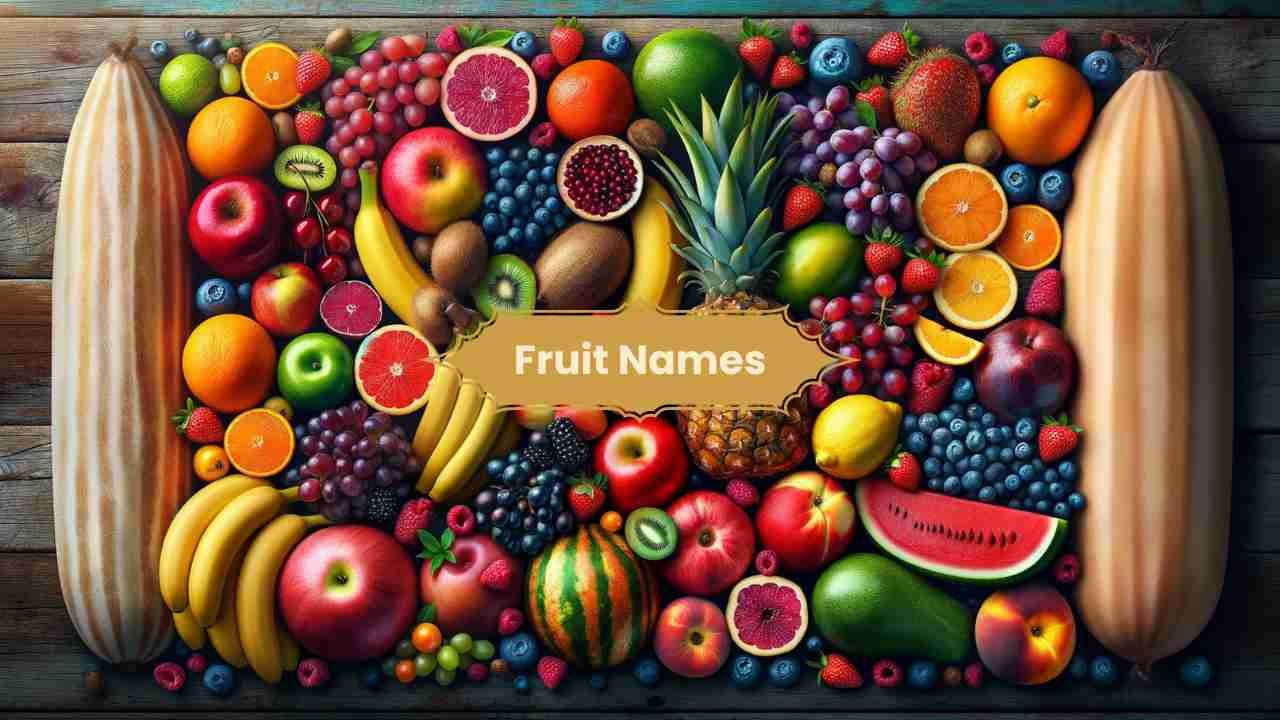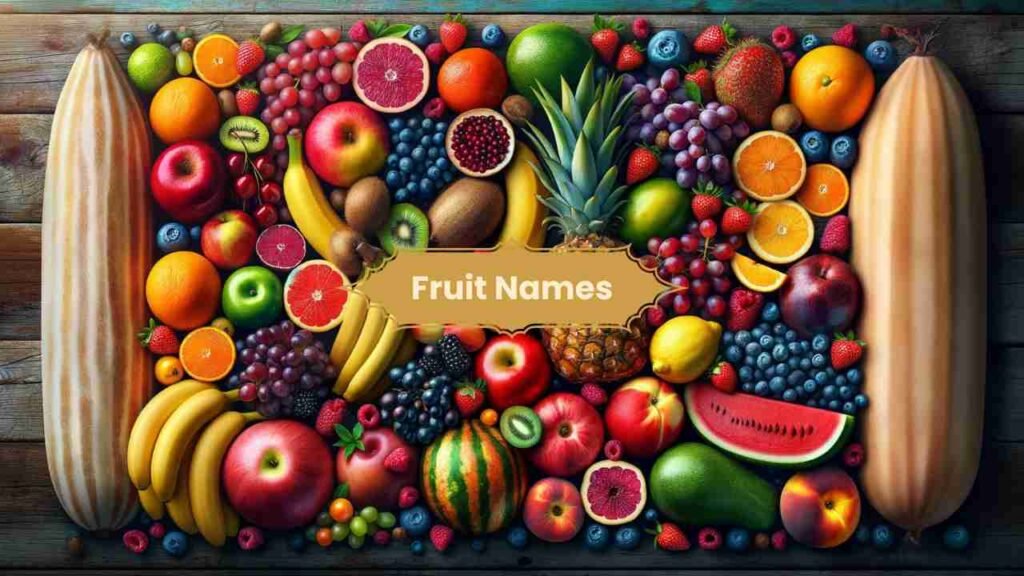Fruit Names for LKG and UKG Students: Welcome to “The Bountiful Orchard,” your one-stop destination for all things fruity! In this blog, we will embark on a delicious journey through the vibrant and diverse world of fruits. From the sweet and succulent to the exotic and mysterious, we’ll explore the incredible variety of fruits that Mother Nature has bestowed upon us.
Fruit Names for LKG and UKG Students

Chapter 1: The Fruity Spectrum
In our first chapter, we’ll delve into the fascinating world of fruits, discussing what exactly defines a fruit and the various categories they fall into. You’ll learn about the differences between berries, drupes, citrus fruits, and more. Understanding these distinctions will set the stage for our exploration of fruits to come.
Chapter 2: Nature’s Candy – Sweet Fruits
In this chapter, we’ll satisfy your sweet tooth as we spotlight nature’s candy – sweet fruits! From the luscious mangoes of India to the juicy peaches of Georgia, we’ll take a close look at some of the world’s most delectable and beloved fruits. You’ll discover their origins, nutritional benefits, and delicious ways to incorporate them into your diet.
Chapter 3: Tangy and Tart – Citrus Fruits
Get ready to pucker up as we explore the zesty world of citrus fruits. Lemons, oranges, grapefruits, and more will take center stage as we uncover their unique flavors, vitamin-packed goodness, and culinary versatility. Whether you’re squeezing fresh orange juice or zesting lemons for a mouthwatering dessert, citrus fruits will add a tangy twist to your life.
Chapter 4: Nature’s Color Palette – Exotic Fruits
In this exotic chapter, we’ll embark on an adventure to discover fruits you may have never encountered before. From the spiky rambutan of Southeast Asia to the vibrant dragon fruit of Central America, these exotic fruits are not only visually stunning but also packed with intriguing flavors and health benefits.
Chapter 5: Beyond the Ordinary – Uncommon and Rare Fruits
Prepare to be amazed by the rare and uncommon fruits that grace our blog in this chapter. We’ll uncover the hidden gems of the fruit world, from the durian’s distinctive odor to the delectable mangosteen’s heavenly taste. These fruits may be hard to find, but they are well worth the effort for their unique and unforgettable flavors.
Chapter 6: Fruits for Every Season
Fruits are as diverse as the seasons themselves, and in this chapter, we’ll explore the best fruits to enjoy during each time of year. Discover which fruits thrive in spring, summer, fall, and winter, and learn how to make the most of their seasonal abundance.
Chapter 7: Fruitful Health Benefits
Fruits aren’t just delicious; they’re also incredibly good for you! We’ll dive into the myriad health benefits of incorporating fruits into your daily diet. From antioxidants to vitamins and fiber, fruits are a powerhouse of nutrition that can enhance your overall well-being.
Conclusion:
“The Bountiful Orchard” is your gateway to a world of flavor, nutrition, and exploration. We hope this blog will inspire you to expand your palate, try new fruits, and appreciate the natural wonders that grow on trees and vines across the globe. Join us on this fruity adventure, and together, we’ll celebrate the incredible diversity and beauty of nature’s sweetest gifts
List of Fruit Names for Kindergarten Students – LKG and UKG
Here is a list of fruit names that are suitable for kindergarten students (LKG and UKG levels):
- Apple
- Banana
- Orange
- Grapes
- Mango
- Strawberry
- Watermelon
- Pineapple
- Kiwi
- Blueberry
- Cherry
- Pear
- Peach
- Lemon
- Plum
- Raspberry
- Papaya
- Avocado
- Cranberry
- Blackberry
- Coconut
- Apricot
- Pomegranate
- Guava
- Fig
These fruit names are simple and commonly known, making them suitable for young children to learn and remember. You can also incorporate fun activities like coloring pages, fruit-themed crafts, and songs to make learning about fruits enjoyable for kindergarten students
Why it is Necessary to Study Fruit Names For LKG and UKG Students?
Studying fruit names for LKG (Lower Kindergarten) and UKG (Upper Kindergarten) students is important for several reasons:
- Vocabulary Development: Learning fruit names helps children expand their vocabulary. It introduces them to new words, helping them communicate more effectively.
- Nutritional Awareness: Teaching children about different fruits can foster an awareness of nutrition and healthy eating habits from an early age.
- Sensory Learning: Fruits are colorful, have different textures, and distinct smells and tastes. Learning about fruits engages multiple senses, which is a key aspect of effective learning in young children.
- Cultural Knowledge: Fruits often have cultural significance. Learning about them can also introduce children to different cultures and traditions associated with certain fruits.
- Cognitive Skills: Classifying and sorting fruits based on different attributes (like color, size, or taste) can enhance cognitive skills such as critical thinking and problem-solving.
- Environmental Awareness: Discussing where and how fruits grow can lead to a better understanding of nature and the environment.
- Language Skills: Learning fruit names in a language class can help in mastering that language, whether it’s their native language or a second language.
- Social Skills: Activities involving fruit (like group discussions, fruit tasting, or drawing) can promote teamwork and improve social interaction among students.
Incorporating fruit names into the curriculum is not just about memorizing words; it’s about building a foundation for healthy habits, cognitive development, and a broader understanding of the world
Fruit Names in English in a Table
| Apple | Banana | Apricot | Atemoya |
|---|---|---|---|
| Avocados | Blueberry | Blackcurrant | Ackee |
| Cranberry | Cantaloupe | Cherry | Black sapote/Chocolate pudding fruit |
| Dragonfruit | Dates | Cherimoya | Buddha’s hand fruit |
| Finger lime | Fig | Coconut | Cape gooseberry/Inca berry/Physalis |
| Grapefruit | Gooseberries | Custard apple/Sugar apple/Sweetsop | Chempedak |
| Hazelnut | Honeyberries | Dragon fruit | Durian |
| Horned melon | Hog plum | Egg fruit | Feijoa/Pineapple guava/Guavasteen |
| Indian fig | Ice apple | Guava | Fuyu Persimmon |
| Jackfruit | Jujube | Honeydew melon | Jenipapo |
| Kiwi | Kabosu | Kiwano | Kaffir lime/Makrut lime |
| Lime | Lychee | Longan | Langsat |
| Mango | Mulberry | Pear | Lucuma |
| Muskmelon | Naranjilla | Passion fruit | Mangosteen |
| Nectarine | Nance | Quince | Medlar fruit |
| Olive | Oranges | Ramphal | Mouse melon |
| Papaya | Peach | Rose apple/Water apple | Noni fruit |
| Pomegranate | Pineapple | Rambutan | Snake fruit/Salak |
| Raspberries | Strawberries | Starfruit/Carambola | Soursop |
| Tangerine | Watermelon | Sapota | Star apple |
Different Types of Fruits
Fruits can be categorized into various types based on their physical characteristics, botanical classifications, and how they develop from the flowering part of a plant. Here are some of the main types of fruits:
- Simple Fruits: These develop from a single ovary of a single flower and can be either fleshy or dry.
- Fleshy Simple Fruits:
- Berries: Characterized by their whole fruit being fleshy, though they may contain seeds. Examples include tomatoes, grapes, and bananas.
- Drupe: Known for having a single seed (or pit) surrounded by a juicy outer layer. Examples are peaches, cherries, and avocados.
- Pome: These fruits have a core, and the surrounding tissue is the edible part. Apples and pears are common examples.
- Dry Simple Fruits:
- Dehiscent: These fruits open up to release seeds when they mature. Examples include legumes (like peas and beans), capsules (like poppies), and follicles (like milkweed).
- Indehiscent: These fruits do not open at maturity and include nuts (like hazelnuts) and grains (like wheat).
- Fleshy Simple Fruits:
- Aggregate Fruits: Formed from a single flower that has multiple ovaries, which each develop into a small fruit. These small fruits cluster tightly together to form the entire fruit. Strawberries, raspberries, and blackberries are examples.
- Multiple Fruits: Develop from the ovaries of multiple flowers growing in a cluster or inflorescence. Each flower in the inflorescence produces a fruit, but they merge to form a single mass. Examples include pineapples and figs.
- Accessory Fruits: These fruits contain tissue not derived from the plant’s ovary but from some adjacent tissues exterior to the carpel. Strawberries and apples are considered accessory fruits because parts of the fruit come from the receptacle or flower parts, not just the ovary.
- Citrus Fruits: A specific type of fleshy fruit that is a modified berry called a “hesperidium.” These fruits have a leathery rind and segmented flesh inside. Examples are oranges, lemons, limes, and grapefruits.
- Melons and Gourds: Members of the Cucurbitaceae family, these fruits are often large and fleshy, with thick rinds and a high water content. Examples include watermelons, cantaloupes, and cucumbers.
- Tropical Fruits: These fruits usually grow in tropical or subtropical climates and are often exotic in taste and appearance. Examples include mangoes, papayas, kiwis, and passion fruits.
- Stone Fruits or Drupes: Characterized by a single large seed or “stone” inside, surrounded by juicy flesh. Examples include peaches, plums, and cherries.
Understanding these categories helps in identifying fruits and understanding their characteristics, origins, and the best ways to use them in cooking and diet
List of Fruits in a Tabular Format with Characteristics Origin Country and Scientific Name
Here’s a table listing 25 fruits along with their characteristics, origin countries, and scientific names:
| Fruit | Characteristics | Origin Country | Scientific Name |
|---|---|---|---|
| Apple | Crunchy, sweet to tart | Kazakhstan | Malus domestica |
| Banana | Soft, sweet, creamy | Southeast Asia | Musa spp. |
| Orange | Juicy, sweet to slightly bitter | China | Citrus × sinensis |
| Mango | Juicy, sweet, and tropical | South Asia | Mangifera indica |
| Watermelon | Juicy, sweet, and grainy | West Africa | Citrullus lanatus |
| Strawberry | Sweet, slightly tart, fragrant | France | Fragaria × ananassa |
| Pineapple | Tart, sweet, and tropical | South America | Ananas comosus |
| Avocado | Creamy, mild, and rich | Mexico | Persea americana |
| Papaya | Sweet, tropical, and soft | Southern Mexico | Carica papaya |
| Kiwi | Sweet, tangy, and juicy | China | Actinidia deliciosa |
| Blueberry | Sweet, tangy, and juicy | North America | Cyanococcus |
| Cherry | Sweet to tart, juicy | Europe and Asia | Prunus avium / Prunus cerasus |
| Pear | Sweet, grainy, and juicy | Central Asia | Pyrus communis |
| Lemon | Sour, tart | Northeast India | Citrus limon |
| Peach | Sweet, juicy, and fuzzy | Northwest China | Prunus persica |
| Raspberry | Sweet, slightly tart | Europe | Rubus idaeus |
| Grape | Sweet, juicy, can be tart | Near East | Vitis vinifera |
| Pomegranate | Sweet, tart, and juicy | Iran | Punica granatum |
| Coconut | Sweet, mild, and nutty | Indo-Malaya region | Cocos nucifera |
| Plum | Sweet to tart, juicy | East Europe & Asia | Prunus domestica |
| Apricot | Sweet, tart, and juicy | Armenia | Prunus armeniaca |
| Fig | Sweet, chewy, and soft | Western Asia | Ficus carica |
| Guava | Sweet, tropical, and slightly tart | Central America | Psidium guajava |
| Blackberry | Sweet, tart, and juicy | Europe, Americas | Rubus spp. |
| Cantaloupe | Sweet, juicy, and soft | Iran | Cucumis melo var. cantalupensis |
This table provides a brief overview of various fruits, highlighting their distinct characteristics, where they originally come from, and their scientific classifications
Citrus Fruits
Here’s a table of the listed citrus fruits along with their approximate calorie counts per 100 grams:
| Citrus Fruit | Calorie Count (per 100g) |
|---|---|
| Orange | 47 kcal |
| Blood Orange | 52 kcal |
| Lemon | 29 kcal |
| Kaffir Lime | 30 kcal (similar to lime) |
| Sweet Lime | 43 kcal |
| Pomelo | 38 kcal |
| Tangerine | 53 kcal |
| Sudachi | 25 kcal (similar to lime) |
| Ugli Fruit | 47 kcal (similar to tangelo) |
| Yuzu Fruit | 25 kcal (similar to lime) |
| Tangelo | 53 kcal |
| Kumquat | 71 kcal |
| Mandarin Orange | 53 kcal |
| Grapefruit | 42 kcal |
The calorie counts provided are approximate values and can vary slightly depending on the variety and ripeness of the fruit. Citrus fruits are not only refreshing and delicious but also low in calories, making them a great choice for a healthy diet
Tropical Fruits
Tropical fruits, including a brief description of each:
| Tropical Fruit | Description |
|---|---|
| Ackee | A rare tropical fruit native to West Africa, known for its bright red skin and toxic if unripe. |
| Avocado | Creamy texture and rich flavor, popular in various cuisines for its health benefits. |
| Banana | Long, yellow fruit with soft, sweet flesh, consumed worldwide. |
| Carambola | Also known as star fruit, it’s yellow with a distinctive star shape when sliced. |
| Coconut | Large, nut-like fruit with a hard shell, edible white flesh, and clear liquid inside. |
| Custard Apple | Soft, sweet flesh with a green, bumpy exterior, also known as cherimoya in some regions. |
| Dragon Fruit | Bright pink or yellow skin with black seeds and white flesh, mild sweet taste. |
| Durian | Known as the “king of fruits”, large with a strong odor and custard-like flesh. |
| Fig | Soft, pear-shaped fruit with sweet dark flesh and many small seeds inside. |
| Grapes | Small, round fruits growing in clusters, available in multiple colors and varieties. |
| Gooseberries | Small, round, sour fruits, often used in desserts and jams. |
| Guava | Common tropical fruit with green skin and pink or white flesh, rich in vitamin C. |
| Jackfruit | Large fruit with a spiky exterior and fibrous, sweet interior flesh that resembles pulled pork. |
| Kiwi | Brown, fuzzy exterior with bright green or yellow sweet and tart flesh inside. |
| Longan | Small, round fruit with a translucent flesh and a large seed, similar to lychee. |
| Lychee | Small fruit with a rough, red skin and sweet, juicy flesh. |
| Mango | Sweet, juicy fruit with a stone in the middle, known for its rich, tropical flavor. |
| Mangosteen | Dark purple fruit with a sweet, tangy, and juicy white interior. |
| Muskmelon | Includes various types like cantaloupe, with sweet, orange flesh. |
| Papaya | Pear-shaped fruit with orange flesh and black seeds, known for its digestive properties. |
| Passion Fruit | Small, round fruit with a tough outer rind and a juicy, seed-filled interior. |
| Persimmon | Orange fruit that can be astringent or sweet, depending on the variety. |
| Pineapple | Tropical fruit with rough, spiky exterior and sweet, juicy, yellow flesh. |
| Pomegranate | Red fruit with a tough outer layer and a multitude of sweet, juicy seeds inside. |
| Rambutan | Hairy red and green fruit, similar to lychee, with juicy, sweet flesh. |
| Rose Apple | Bell-shaped fruit with a waxy skin and crunchy, watery flesh, similar to a water apple. |
| Star Apple | Round, purple fruit with a star pattern when cut and sweet, milky flesh. |
| Watermelon | Large fruit with a green exterior and sweet, juicy, red or yellow flesh with seeds. |
Tropical fruits are celebrated for their unique flavors, textures, and nutritional benefits, making them popular in cuisines around the world
Yellow Fruits
Yellow fruits, including a brief description of each:
| Yellow Fruit | Description |
|---|---|
| Banana | Elongated fruit with a soft, sweet flesh, known for its yellow peel and high potassium content. |
| Pineapple | Tropical fruit with spiky, tough outer skin and sweet, juicy, yellow flesh. |
| Mango | Juicy fruit with a sweet and fragrant flavor, often with yellow flesh when ripe. |
| Yellow Pear | A variety of pear with a bright yellow skin and sweet, juicy flesh. |
| Papaya | Tropical fruit with orange-yellow flesh, known for its sweet taste and digestive enzymes. |
| Egg Fruit | Named for its egg-like texture, this fruit has sweet, yellow flesh and is also known as canistel. |
| Guava | Some varieties have yellow skin and soft, sweet flesh, rich in Vitamin C. |
| Jackfruit | Large fruit with fibrous, sweet yellow flesh segments, used in both sweet and savory dishes. |
| Must Melon | Likely a mistype for “Muskmelon,” which has sweet, fragrant, yellow to orange flesh. |
| Canary Melon | Bright yellow melon with a sweet, white flesh, known for its smooth texture. |
| Durian | Known for its strong odor, the fruit has creamy yellow flesh with a complex flavor. |
| Yellow Peach | A variety of peach with a yellow flesh, known for its juicy and sweet taste. |
| Grapes | Some grape varieties have a yellow-green hue and a sweet, tart flavor. |
| Yellow Watermelon | A variety of watermelon with yellow flesh, known for its sweet taste, similar to the red variety. |
| Pomelo | Large citrus fruit with a yellow-green skin and sweet, tangy, pale yellow flesh. |
| Yellow Dragon Fruit | A variety of dragon fruit with yellow skin and white or pink flesh with black seeds. |
| Yellow Apple | Includes varieties like Golden Delicious, known for their yellow skin and sweet taste. |
| Yellow Plum | Also known as Lemon Plum, a small, sweet fruit with yellow skin and flesh. |
| Golden Kiwi | A type of kiwifruit with smooth, bronze skin and a sweet, golden flesh. |
| Husk Cherry | Small, sweet fruit enclosed in a papery husk, with a yellow, tomato-like flesh. |
| Passion Fruit | Some varieties have a yellow rind with sweet, tart, and aromatic yellow seeds and pulp. |
| Yellow Fig | A variety of figs with yellow skin and sweet, amber flesh inside. |
| Quince | A pear-like fruit with a bright yellow skin, used in jams and jellies due to its high pectin. |
| Cantaloupe | Also known as sweet melon or rock melon, with a netted skin and sweet, orange-yellow flesh. |
These yellow fruits are known for their vibrant color, distinct flavors, and nutritional benefits, ranging from high vitamin content to digestive aids
Green Fruits
Green fruits, including a brief description of each:
| Green Fruit | Description |
|---|---|
| Green Apple | Tart and crisp variety of apples with a bright green skin. |
| Breadfruit | Large tropical fruit with a starchy texture, used similarly to potatoes in cooking. |
| Avocado | Creamy fruit with a rich, buttery texture, often used in salads and spreads. |
| Durian | Large, spiky fruit known for its strong odor and creamy, custard-like green flesh. |
| Green Grapes | Small, round fruits that are sweet and tart, used in wines, snacks, and juices. |
| Jackfruit | Tropical fruit with a green exterior and sweet, yellow-green fibrous flesh inside. |
| Pear | Sweet fruit with a green skin and juicy, white flesh, available in many varieties. |
| Sugar Apple/Custard Apple | Sweet fruit with a green, bumpy exterior and creamy, segmented flesh inside. |
| Green Gooseberry | Small, tart fruit with a green skin, often used in pies and jams. |
| Marang | Tropical fruit similar to jackfruit and breadfruit, with a green exterior and sweet flesh. |
| Kiwi Fruit | Small fruit with a brown, fuzzy exterior and bright green, sweet-tart flesh inside. |
| Guava | Common tropical fruit with a green skin and pink or white flesh, rich in Vitamin C. |
| Honeydew Melon | Sweet melon with a smooth, green exterior and pale green, juicy flesh. |
| Jocote | Small fruit, also known as Spanish plum, with green to red skin and sweet-sour flesh. |
| Pomelo | Large citrus fruit with a thick, green-yellow skin and sweet, tangy flesh. |
| Star Fruit | Also known as carambola, this fruit has a distinctive star shape when sliced and tart flesh. |
| Soursop | Tropical fruit with a spiky green exterior and soft, white, fibrous flesh with a unique flavor. |
| Feijoa | Also known as pineapple guava, with a green exterior and sweet, aromatic flesh. |
| True Medlar/Greengage Plum | Sweet and juicy plum variety with a green skin and flesh when ripe. |
| Chempedak | Similar to jackfruit, with a green exterior and sweet, yellow flesh inside. |
| Ugli Fruit | Citrus fruit with a rough, greenish exterior and sweet, tangy flesh. |
| Noni Fruit | Known for its strong odor and taste, the fruit has a green, bumpy exterior. |
| Osage Orange | Not commonly eaten, this large, green fruit is more decorative or used for hedge planting. |
| Chayote | Green, pear-shaped vegetable fruit often used in salads, soups, and stews. |
These green fruits offer a range of flavors, textures, and nutritional benefits, from the creamy richness of avocado to the tart crispness of green apples
Detailed information about some common fruits:
| Name of the Fruit | About It |
|---|---|
| Apple | Apples are cultivated worldwide and are known for their adaptability to various climates. They are a popular fruit for raw consumption and cooking due to their sweet to tart flavor spectrum. Apples are also valued for their health benefits, including fiber content and various vitamins. |
| Avocado | Originating from south-central Mexico, avocados are known for their creamy texture and rich, nutty flavor. They are highly nutritious, containing monounsaturated fats, fiber, and nearly 20 vitamins and minerals, making them a staple in health-conscious diets. |
| Apricot | Apricots are small, golden-orange fruits with velvety skin and flesh that’s not too juicy but quite smooth and sweet. They are high in beta-carotene and fiber, contributing to their antioxidant properties and making them beneficial for eye health. |
| Abiu | Native to the Amazon region, abiu has a smooth, bright yellow skin and sweet, jelly-like pulp. It is often eaten fresh and is noted for its exotic flavor, reminiscent of caramel and custard. Abiu is also rich in vitamins C and B, calcium, and phosphorus. |
| Banana | Bananas are a widely consumed fruit known for their convenience, nutritional value, and energy-boosting carbohydrates. They come in many varieties, with the most common being the sweet, yellow type when ripe and the starchy, green plantains used for cooking. |
| Blackberry | Blackberries grow in temperate regions of the world and are known for their aggregate fruit structure, comprising many small drupelets. They are high in fiber, vitamins C and K, and antioxidants, making them beneficial for heart health and inflammation. |
| Blueberry | Native to North America, blueberries are small, round, and deep blue in color. They are famous for their antioxidant properties, particularly anthocyanins, which contribute to heart health and cognitive function. |
| Bael | Also known as wood apple, bael is native to the Indian subcontinent and Southeast Asia. It is known for its hard shell, aromatic, and sweet flesh, which is often used in drinks and religious rituals in India. |
| Cranberry | Cranberries are native to North America and are a major commercial crop in certain American states and Canadian provinces. They are known for their tart taste and are often processed into products like juice, sauce, and dried fruit. Cranberries are also valued for their potential urinary tract infection (UTI) prevention properties. |
| Cherry | Cherries are small, round fruits that come in various colors and flavors, ranging from sweet to tart. They are enjoyed fresh, in cooking, and in beverages and are known for their antioxidant and anti-inflammatory properties. |
| Dates | Dates are the fruit of the date palm tree and are native to the Middle East. They are known for their sweet taste and chewy texture and are often eaten dried. Dates are nutritious, high in fiber, and a natural sweetener in various dishes. |
| Dragonfruit | Also known as pitaya, dragonfruit has a unique appearance with its bright pink skin and speckled, white flesh. It is mildly sweet and is often consumed fresh or used in beverages and desserts. Dragonfruit is low in calories but rich in vitamins, minerals, and antioxidants. |
| Fig | Figs are native to the Middle East and western Asia and have been cultivated since ancient times. They can be eaten fresh or dried and are known for their unique, sweet taste and chewy texture. Figs are high in fiber and minerals, making them beneficial for digestive health. |
| Guava | Guava is a tropical fruit that can vary in color from yellow to dark red. It has a unique flavor that can range from sweet to tart and is highly nutritious, offering more vitamin C than an orange. |
| Grapes | Grapes are versatile fruits used in making wine, eaten fresh as table grapes, or dried to produce raisins. They come in various colors and sizes and are known for their sweet and sometimes tart flavor. Grapes are rich in antioxidants, particularly resveratrol, which is linked to heart health. |
| Grapefruit | Grapefruit is a citrus fruit known for its slightly bitter and sour taste. It is a hybrid of pomelo and sweet orange and is rich in vitamins, particularly vitamin C, and antioxidants. Grapefruit is often associated with diet and weight loss due to its potential fat-burning properties. |
Each of these fruits offers unique flavors, textures, and health benefits, contributing to a diverse and nutritious diet
Importance of Knowing Fruits
Understanding and learning the names of fruits is more than just an academic exercise; it plays a significant role in various aspects of a child’s development and learning. Here are some reasons why knowing fruit names is important:
- Nutritional Education: Recognizing different fruits by name helps children understand the importance of a balanced diet. When children can identify fruits, they can learn about the specific nutritional benefits each fruit offers, such as vitamins, minerals, and fiber, contributing to their overall health and well-being.
- Cultural Awareness: Fruits are an integral part of many cultures’ cuisines and traditions. By learning about different fruits, children gain insights into diverse cultures and practices around the world. This can foster a sense of curiosity and appreciation for global diversity.
- Language and Cognitive Development: Learning fruit names enhances vocabulary and linguistic skills. It also aids in cognitive development by categorizing fruits based on characteristics like color, taste, and texture, which are fundamental cognitive skills.
- Sensory Skills: Exploring various fruits allows children to engage their senses—seeing different colors, feeling textures, smelling aromas, and tasting flavors. This sensory play supports sensory development and can be a delightful learning experience.
- Environmental Awareness: Understanding where and how fruits grow can teach children about nature and the environment. It can inspire an interest in gardening, agriculture, and the importance of sustainable practices.
- Health Consciousness: Early exposure to a variety of fruits can encourage healthier eating habits. Children who are familiar with a range of fruits are more likely to include them in their diet, leading to healthier lifestyle choices.
- Social and Emotional Development: Discussing fruits can be a social activity that promotes sharing, turn-taking, and cooperation among children. It can also evoke emotions and memories associated with tasting or eating fruits during special occasions or family gatherings.
- Critical Thinking and Decision Making: As children learn about fruits, they can make informed choices about their preferences and dietary needs. This decision-making process is a critical life skill.
- Encourages Exploration and Curiosity: Learning about fruits, especially exotic ones, can spark curiosity and a desire to explore and try new things, which is a valuable trait for lifelong learning.
- Promotes Inclusivity: In multicultural settings, discussing various fruits can be a way to include all children, as they may share fruits common to their culture, promoting inclusivity and respect for differences.
In summary, knowing fruit names and learning about fruits is an integral part of children’s education that touches on health, culture, cognitive development, and more. It lays a foundation for lifelong habits and curiosity about the natural world
FAQs About Fruit Names
1. What is the most commonly consumed fruit in the world?
Answer: Bananas are among the most commonly consumed fruits globally due to their convenience, nutritional value, and widespread availability.
2. Can you eat the skin of a kiwi fruit?
Answer: Yes, the skin of a kiwi fruit is edible and contains high levels of fiber and vitamin C.
3. What fruit is known as the “king of fruits” and why?
Answer: Durian is often called the “king of fruits” due to its large size, distinctive odor, and rich custard-like texture.
4. Is tomato a fruit or a vegetable?
Answer: Botanically, a tomato is a fruit because it develops from the ovary of a flower and contains seeds. However, in culinary contexts, it’s often treated as a vegetable.
5. What fruit has the highest water content?
Answer: Watermelon, which consists of about 92% water, making it one of the fruits with the highest water content.
6. Which fruit is known for having the most vitamin C?
Answer: Kakadu plums contain the highest known concentration of vitamin C of any food, but among more common fruits, guavas and kiwis are excellent sources.
7. What’s the difference between a nectarine and a peach?
Answer: Nectarines and peaches are very similar, but nectarines have a smooth skin, while peaches have a fuzzy exterior.
8. Are strawberries true berries?
Answer: Botanically speaking, strawberries are not true berries because their seeds are on the outside. True berries, like blueberries and grapes, have seeds inside.
9. What fruit is known as “Chinese gooseberry”?
Answer: The kiwifruit was originally known as “Chinese gooseberry” before being renamed for marketing purposes in the mid-20th century.
10. Which fruit is a natural meat tenderizer?
Answer: Pineapple contains bromelain, an enzyme that breaks down proteins and can tenderize meat.
11. What is the sweetest fruit in the world?
Answer: Mangoes are often considered one of the sweetest fruits when fully ripe, although this can vary by variety.
12. Can lemons ripen after they are picked?
Answer: Lemons can slightly ripen after being picked in terms of softening, but they will not become significantly sweeter like some other fruits.
13. What fruit is known for its eye health benefits?
Answer: Carrots are well-known for eye health due to their high vitamin A content, but they’re technically a vegetable. For fruits, oranges and other citrus fruits are beneficial for eye health due to their high vitamin C and antioxidant content.
14. What is the most expensive fruit in the world?
Answer: The Yubari King melon, a type of cantaloupe from Japan, is known for being one of the most expensive fruits, often selling for thousands of dollars in auctions.
15. What fruit has a star shape when cut across the middle?
Answer: Starfruit, or carambola, has a distinctive star shape when sliced crosswise.
16. Are bananas genetically modified?
Answer: The bananas commonly consumed today are not genetically modified organisms (GMOs) in the sense of being lab-engineered. However, they have been extensively bred through conventional agricultural practices to enhance desirable traits.
17. What fruit is known to be the most hydrating?
Answer: Watermelon is known to be one of the most hydrating fruits due to its high water content.
18. Why are seedless grapes seedless?
Answer: Seedless grapes are bred through a natural mutation that occurs in some grape varieties, which is then propagated through cuttings and grafting.
19. Can eating too much fruit be harmful?
Answer: While fruits are healthy, eating them in excessive amounts can lead to excessive sugar intake and potential digestive issues due to high fiber content.
20. What is a pomelo?
Answer: A pomelo is a large citrus fruit that is similar to, but larger than, a grapefruit. It has a sweeter and milder taste.
21. Why do apples float in water?
Answer: Apples float in water because they contain air spaces that make them less dense than water.
22. What fruit is a symbol of hospitality?
Answer: The pineapple has been a symbol of hospitality since the days of early American colonies.
23. What is the main difference between blackberries and raspberries?
Answer: When picked, raspberries detach from their core and leave a hollow center, whereas blackberries remain solid.
24. Can you eat the seeds of a pomegranate?
Answer: Yes, pomegranate seeds are edible and are packed with fiber, vitamins, and minerals.
Learn With Suniltams Guruji
Register for My Upcoming Masterclass HERE
See You in the Live Masterclass
Sunil Chaudhary stands as a preeminent global Leading digital coach, boasting a diverse clientele hailing from over 50 nations. Renowned for his prowess as an exemplary SEO expert, business automation coach, and landing page authority, Chaudhary also holds the distinction of being esteemed as the finest business coach in India. Beyond technical domains, he imparts invaluable insights into mindset, success, and life skills, thus encompassing a holistic approach to mentorship.
Join FREE Courses HERE
Know The Author:
 Sunil Chaudhary aka Suniltams Guruji is India’s Leading Digital Coach. He provides complete Digital Skill Development Coaching with great support. Sunil has trained more than 25000 students and helped more than 1100 businesses so far. Sunil is a well-known face across the world for Digital Coaching.
Sunil Chaudhary aka Suniltams Guruji is India’s Leading Digital Coach. He provides complete Digital Skill Development Coaching with great support. Sunil has trained more than 25000 students and helped more than 1100 businesses so far. Sunil is a well-known face across the world for Digital Coaching.
Digital Success Coach | Best SEO Coach India | Mindset Coach | Life Success Coach
General Knowledge | Tips | Blogging | Digital Marketing | English Language | SEO | Travel | Food | Motivation | Entertainment |
















